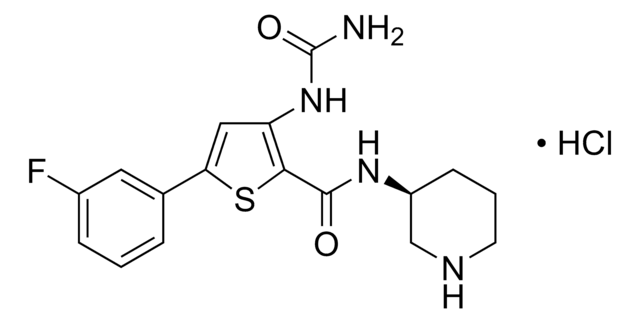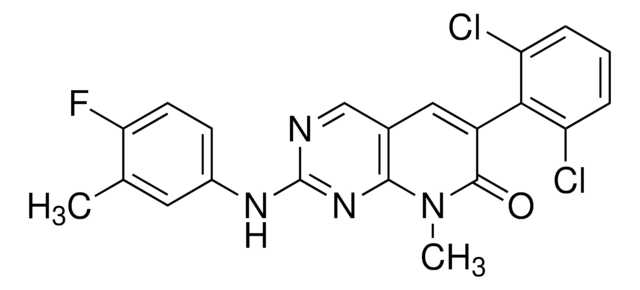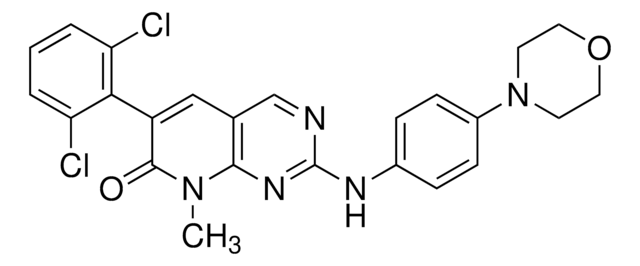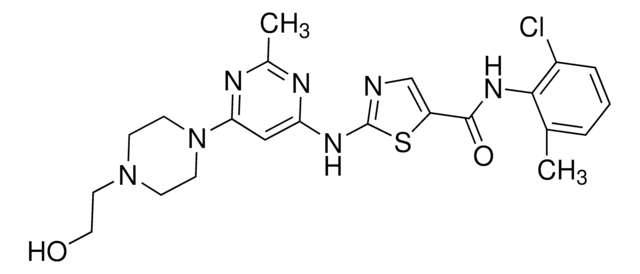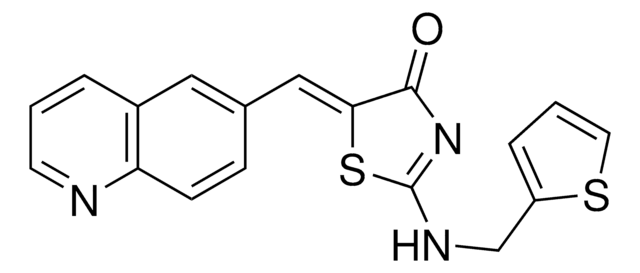推薦產品
化驗
≥98% (HPLC)
形狀
powder
顏色
yellow
溶解度
DMSO: ≥20 mg/mL
H2O: ≥5 mg/mL
儲存溫度
room temp
SMILES 字串
O.Cl.Cl.CCN(CC)CCOc1ccc(Nc2ncc3C=C(C(=O)N(C)c3n2)c4c(Cl)cccc4Cl)cc1
InChI
1S/C26H27Cl2N5O2.2ClH.H2O/c1-4-33(5-2)13-14-35-19-11-9-18(10-12-19)30-26-29-16-17-15-20(25(34)32(3)24(17)31-26)23-21(27)7-6-8-22(23)28;;;/h6-12,15-16H,4-5,13-14H2,1-3H3,(H,29,30,31);2*1H;1H2
InChI 密鑰
FHIIMEXCWLFXBU-UHFFFAOYSA-N
應用
PD-166285 Hydrate has been used as a fibroblast growth factor (FGF) signaling inhibitor to study its effects on LIM-homeodomain gene 9 (Lhx9) expression during limb development in mice.
生化/生理作用
PD-166285 is also a potent inhibitor of Wee-1, epidermal growth factor receptor, and platelet-derived growth factor receptor β subunit (PDGFR-β). It also exhibits its inhibitory effects against mitogen-activated protein kinase (MAPK) and protein kinase C (PKC). PD-166285 shows antiproliferative and anti-migratory effects due to which it may be used as a therapeutic agent against atherosclerosis, restenosis, and cancer.
PD-166285 hydrate is a broad spectrum protein tyrosine kinase inhibitor; Src and FGFR kinase inhibitor.
特點和優勢
This compound is featured on the FGFR page of the Handbook of Receptor Classification and Signal Transduction. To browse other handbook pages, click here.
訊號詞
Danger
危險聲明
危險分類
Acute Tox. 3 Oral - Aquatic Chronic 4
儲存類別代碼
6.1C - Combustible acute toxic Cat.3 / toxic compounds or compounds which causing chronic effects
水污染物質分類(WGK)
WGK 3
閃點(°F)
Not applicable
閃點(°C)
Not applicable
分析證明 (COA)
輸入產品批次/批號來搜索 分析證明 (COA)。在產品’s標籤上找到批次和批號,寫有 ‘Lot’或‘Batch’.。
客戶也查看了
Suzanne Leijen et al.
Current clinical pharmacology, 5(3), 186-191 (2010-04-22)
Inducing DNA damage is a well known strategy for attacking cancer, already being used for many years by the application of a variety of anti cancer drugs. Tumor cells and other rapidly dividing cells are more sensitive to DNA damage
我們的科學家團隊在所有研究領域都有豐富的經驗,包括生命科學、材料科學、化學合成、色譜、分析等.
聯絡技術服務